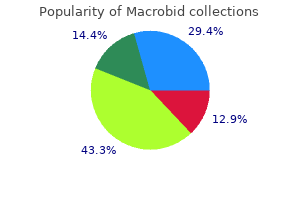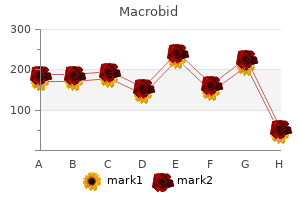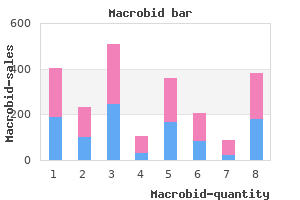"Buy macrobid 100mg without prescription, gastritis grapes".
O. Brenton, M.A., M.D., Ph.D.
Clinical Director, George Washington University Medical School
Trichromatically stained section showing myriad small nemaline rods in a patient with nemaline rod myopathy gastritis what not to eat generic 100 mg macrobid with visa. Ion channelopathies (see E-Table 393-3) are genetically determined disorders in which the muscle membrane functions abnormally gastritis treatment probiotics 100 mg macrobid order fast delivery. The combined prevalence of the various skeletal muscle channelopathies is about 1 gastritis diet symptoms macrobid 50 mg purchase online. Patients present with painless myotonia, muscle stiffness that may be slightly worse in the cold and improves with exercise (the warm-up phenomenon), muscle hypertrophy, and grip and percussion myotonia. Periodic paralysis is typically precipitated by sustained exercise that leads to weakness during the rest period, by potassium-rich food, or sometimes by emotional stress or cold. The attacks can persist for hours, during which the patient can be quadriplegic with depressed tendon reflexes but normal sensation, eye movements, and respiration. The physical examination is usually normal between attacks, but some patients develop fixed proximal weakness later in the disease. In patients with paramyotonia, the muscle stiffness paradoxically increases with exercise and is often painful. Cold sensitivity is typically more extreme than that seen in myotonia congenita, and cold can precipitate the muscle weakness. The diagnosis is made clinically, although patients with fixed proximal muscle weakness, which can be confused with other myopathies, have vacuolar changes and sometimes tubular aggregates on muscle biopsy. For both phenotypes, management involves avoidance of precipitating factors such as cold or strenuous exercise. If the myotonia is disabling, medications that act on sodium channels such as dichlorphenamide (50 to 200 mg daily), acetazolamide (250 mg twice daily), mexiletine (150 mg three times a day), phenytoin (300 to 600 mg daily), and carbamazepine (400 to 800 mg daily) can be considered. The attacks of weakness, which are usually more severe and prolonged than in hyperkalemic period paralysis, generally persist for hours to days before gradually resolving. Attacks occur spontaneously or during prolonged rest after vigorous exercise and also can be precipitated by a high-carbohydrate meal. Avoidance of high carbohydrate loads and treatment with acetazolamide (125 to 1000 mg/day) or dichlorphenamide (50 to 200 mg/day) A5 are effective in hypokalemic periodic paralysis. Periodic paralysis can occur in a wide range of metabolic and electrolyte disorders (Table 393-5). For patients with sulfa allergy, potassium-sparing diuretics such as spironolactone (25 to 100 mg/day) or triamterene (25 to 100 mg/day) can be used. There are case reports of treatment with dantrolene, verapamil, or nifedipine with varying success. Neuromyotonia (Isaac syndrome) is an autoimmune disorder associated with peripheral nerve hyperexcitability. Oral immunomodulatory therapy, intravenous immunoglobulin, plasmapheresis, and symptomatic therapy with carbamazepine or phenytoin have been used with varying response. Rippling muscle syndrome and neuromyotonia can be paraneoplastic phenomena, and a search for malignancy should be considered in these patients. Metabolic Myopathies Metabolic myopathies (see E-Table 393-4) are caused by enzyme defects that affect the three principal stages of muscle metabolism: (1) carbohydrate disorders due to a defect of glucose-glycogen metabolism; (2) disorders of fatty acid oxidation; and (3) disorders of mitochondrial oxidative phosphorylation. Muscle dysfunction can be acute, recurrent, and reversible, but the exercise intolerance can cause progressive weakness or even rhabdomyolysis (Chapter 105). Because glucose and glycogen are the primary energy sources for muscle contraction, any defects of glucose-glycogen metabolism cause muscle pain, cramps, contracture, and weakness within the first 30 minutes of exercise. The most common form is myophosphorylase deficiency (Chapter 196), and other forms are extremely rare. Most of these disorders are inherited autosomal recessively, although phosphoglycerate kinase deficiency is X-linked. Persistent exercise beyond 30 minutes leads to the "second-wind" phenomenon, when fatty acids become the primary source of muscle energy. A high-protein diet and 37 g or 75 g of oral sucrose shortly before exercise and graded exercise may improve symptoms, but patients are at risk for developing contractures.
Syndromes
- Alcoholism in the mother
- Tearing of your eye
- Having sex or intimate contact
- Has no appetite
- Vomiting
- Bring your insurance card the first time you fill the prescription.
- Watery diarrhea (often five to 10 times per day)
- Vomiting

Orthostatic hypotension is defined as a reduction in systolic blood pressure of at least 20 mm Hg or a reduction in diastolic blood pressure of at least 10 mm Hg gastritis hiv symptom buy generic macrobid 100 mg line, with or without symptoms gastritis in cats order 50mg macrobid fast delivery, within 1 to 3 minutes of assuming an erect posture gastritis diet xone 100 mg macrobid buy mastercard. Measurements taken immediately on standing can be misleading, because healthy young persons without orthostatic hypotension will sometimes exhibit transient hypotension that resolves within 30 seconds of standing. Neurogenic orthostatic hypotension is typically sustained with continued standing. Except in patients treated with -blockers, orthostatic hypotension without reflex tachycardia is evidence of generalized adrenergic failure. If reflex tachycardia occurs, dehydration or excessive venous pooling should be considered. Some patients with orthostatic intolerance on standing experience an abnormal rise in heart rate rather than a drop in blood pressure. Postural tachycardia syndrome9 is defined as a sustained increase in heart rate by more than 30 beats per minute in adults (40 beats per minute in adolescents) and often greater than 120 beats per minute when standing. Appropriate laboratory testing depends on the type and distribution of autonomic dysfunction. Investigations may include a complete blood cell count, fasting glucose, electrolytes, morning cortisol, thyroid function testing, vitamin B12 level, serum protein electrophoresis, and, when indicated, autoimmune markers. In a patient with an autonomic neuropathy, seropositivity for antibodies to the alpha-3 ganglionic neuronal acetylcholine receptor is diagnostic of autoimmune autonomic ganglionopathy. The most sensitive screening test for pheochromocytoma is the plasma free metanephrine level (Chapter 215). Postvoiding residual volumes or urodynamic studies can clarify patterns of urinary bladder dysfunction (Chapter 23). Ambulatory blood pressure testing (Chapter 70), usually over a period of 24 hours, is useful to detect patterns of nocturnal hypertension, postprandial hypotension, and the labile hypertension of baroreflex failure. Adrenergic function is assessed by tilt table testing (Chapter 56) or beat-to-beat blood pressure responses to the Valsalva maneuver. Sudomotor dysfunction, which is often a sign of autonomic involvement in small fiber neuropathies,10 can be assessed functionally by quantitative sudomotor axon reflex testing or structurally by epidermal biopsy examining nerve fiber density. Among patients with pure autonomic failure, about one third will develop dementia with Lewy bodies, Parkinson disease, or multiple system atrophy within the next 5 or so years. Diabetic cardiovascular autonomic neuropathy is associated with an approximately two-fold increased risk for silent myocardial ischemia and overall mortality. Elderly patients may be able to use regular physical exercise to compensate for some of the age-associated decline in autonomic function. Efforts at treating the underlying cause of an autonomic neuropathy should be pursued. Good control of glucose in patients with diabetes mellitus (Chapter 216) reduces the rate of complications, including neuropathy. Regional sympathetic dysfunction may accompany the pain that sometimes follows peripheral nerve injuries. For example, sympathetic activation can occur as a normal physiologic response to any painful state. Complex regional pain syndrome is characterized by severe ongoing neuropathic pain that is disproportionate in intensity, duration, and distribution to the expected sequela of limb trauma. The vasomotor changes are manifested as vasodilation with a warm, red, or swollen limb, or alternatively as vasoconstriction with a cold pale limb. Regional dystrophic changes, such as dry atrophic skin, sparse or coarse hair, brittle nails, and osteopenia, may also develop. Although sympathetic dysfunction may be pronounced, it does not appear to cause the pain. The mechanisms of pain and sympathetic dysfunction in this condition are incompletely understood and may result from crosstalk among aberrantly regenerated peripheral nerve fibers, expression of a new -adrenergic receptors on sensory nerve fibers and sweat glands, release of substance P and pro-inflammatory peptides at the site of injury, and sensitization of pain-mediating structures at multiple levels within the central nervous system. Mobilization of the affected limb is of paramount importance in the early treatment of complex regional pain syndrome.

The prevalence of the different alleles change depending on the population studied [155 gastritis wiki discount 50mg macrobid free shipping,156] gastritis symptoms heart attack 100 mg macrobid buy with amex. A mother will transmit the affected allele to 50% of her sons or daughters gastritis symptom of celiac disease macrobid 100 mg generic fast delivery, while a father will pass it on to all his daughters and none of his sons. Based on Rajaratnam A, Shergill J, Salcedo-Arellano M, Saldarriaga W, Duan X, Hagerman R. In contrast, in adult women it is expressed in granulosa cells of mature follicles [172]. Their expression pattern and levels differentially shift during ovarian development and folliculogenesis [187]. Clinical Scenarios Role of telomeres in premature ovarian insufficiency 185 Role of telomeres in premature ovarian insufficiency There are several molecular pathways implicated in organismal aging but the telomere pathway, whose function is to safeguard chromosome stability, is a critical one because it is betrothed to and affects other pathways implicated in aging [191]. Independent studies by Leonard Hayflick had shown that cells grown in culture could only undergo a limited number of divisions. However, Blackburn and colleagues observed telomere length variations in Tetrahymena [195] and hypothesized that a terminal-transferase activity could add repeats onto telomere ends during replication, and that this transferase might be responsible for those variations in telomere length. The telomere sequence and the T-loop are bound by a complex of proteins that protect chromosome ends from degradation and repair activities [205]. Telomere and subtelomere regions contain heterochromatic marks which protect telomeres from unscheduled recombination [208] and control telomere length [209]. Telomeres and aging Cell division is required to maintain tissue homeostasis and organ function during the life span of individuals, but after many divisions, B. Genetics of premature ovarian insufficiency telomeres can be reduced to a critically short length. When this happens, shelterins cannot bind and protect telomeres and the T-loop structure cannot be sustained [213], leaving telomeres more accessible to repair and degradation activities. If most telomeres had a critically short length, cells would enter crisis [214], leading to chromosome instability, which is a hallmark of cancer. Furthermore, if adult stem cells have critically short telomeres and cannot further divide, tissue homeostasis would be compromised. However, the rate of telomere shortening, and not absolute telomere length, is related to organismal life span [217]. In mice telomeres shorten approximately 7000 bases per year while in humans, telomere attrition is about 100 times slower [217]. Telomerase, which is activated during the blastocyst stage [218,219] can counteract telomere shortening by adding de novo repeats to telomeres, but this activity is undetectable in most cells of the organism, except for embryonic and adult stem cells, the germ line, and cancer cells [220]. Although the lack of telomerase activity may be seen as a disadvantage, it is a mechanism for cancer protection [221]. Attempts to dissect the function of telomerase in aging led to the generation of telomerase-deficient mice [197,222,223] which had short telomeres, decreased regenerative capacity, and a shorter life span [197,222,223], but were cancer resistant. In a very elegant experiment, Jaskelioff and coworkers demonstrated that telomerase reactivation in the fourth generation of mice lacking telomerase reversed tissue degeneration [224]. Indeed, better tissue regeneration was found, but also, a decreased in survival due to spontaneous cancer incidence at young ages [225]. When telomerase was overexpressed in cancer-resistant mice, the regenerative capacity of tissues was higher and the life span was significantly increased [226]. Similar results were observed when telomerase was overexpressed in wildtype mice during adulthood, 1- and 2-year-old mice [227], with an increase in life span and normal incidence of spontaneous cancer. These results are critical to design possible telomerase treatments in humans without increasing the risk of cancer. In humans, accelerated telomere attrition caused bay mutations in genes related to telomere maintenance and telomerase, increasing the risk of suffering agingassociated diseases [228]. Telomeres in female reproduction Ovaries are atypical because they age at a faster pace than the rest of the organs. Apart from the environmental insults that organs can be exposed to , undoubtedly, genetic factors affect ovarian function. In wild-type mice, telomeres are longer in immature oocytes, and their length shortens as they become mature.

When urticarial lesions are present for more than 24 hours gastritis biopsy purchase 100mg macrobid amex, underlying urticarial vasculitis should be suspected gastritis diet ������ macrobid 50 mg line. For mild urticaria limited to the skin gastritis symptoms nhs direct generic macrobid 50 mg visa, traditional oral antihistamines (diphenhydramine) or the newer nonsedating agents (terfenadine, cetirizine, loratadine) can be administered intermittently as needed (Table 411-2). If the urticaria is severe, short-term corticosteroids, up to 1 mg/kg, can be used. Finding the cause and removing the antigen of chronic recurrent urticaria is highly preferable to chronic administration of corticosteroids or antihistamines. The patient should avoid aspirin compounds and other drugs that could be the cause. For chronic spontaneous urticaria that persists, omalizumab, an anti-IgE monoclonal antibody at 300 mg subcutaneously once per month, A3 or cycloclosporine (at doses of 3 mg/kg or higher for 8 to 16 weeks), is effective in 65 to 70% of patients who do not respond to H1-antihistamines. Urticaria and exanthematous eruptions are common manifestations of cutaneous drug reactions. Less commonly seen are fixed drug, lichenoid, pustular, phototoxic, bullous, or vasculitic reactions, and the spectrum of erythema multiforme, Stevens-Johnson syndrome, and toxic epidermal necrolysis. Drug rashes, which result from drug toxicity, overdose, drug-drug interactions, or products of metabolism, may be caused by immunologic or nonimmunologic mechanisms. Drugs or their metabolites can act as haptens and induce cell-mediated or humoral responses. Drug rashes are either immediate (urticaria) or delayed hypersensitivity reactions (exanthems). Immediate reactions such as pruritus, hives, angioedema, and anaphylaxis occur within minutes to a few hours after the drug is taken. After sensitization to a particular drug has occurred, readministration of the same drug may trigger an eruption within 24 to 72 hours. They characteristically begin on the face and upper trunk and progress to the lower extremities, where they may become purpuric. Exanthems secondary to drugs most often become confluent erythematous patches after several days. The differential diagnosis for drug rashes includes viral exanthems (Chapter 410), graft-versus-host disease or the leukocyte recovery rash after allogeneic bone marrow transplantation, erythematous exanthems that accompany streptococcal (scarlet fever [Chapter 274]) or staphylococcal (toxic shock syndrome [Chapter 272]) infections, and the acute manifestation of collagen vascular diseases. A similar exanthem occurs when ampicillin is administered to patients who have infectious mononucleosis. It typically begins as a morbilliform eruption, which later evolves into an edematous pustular eruption with erythroderma and purpura. The rash begins on the face, upper trunk, and extremities and later becomes generalized. With visceral involvement, there is a 10% mortality rate, usually from hepatic failure. For patients who develop exfoliative dermatitis, admission to a specialized unit such as a burn unit or intensive care unit is critical. Stevens-Johnson syndrome is defined as mucosal involvement with less than 10% body surface area involvement; toxic epidermal necrolysis is defined as skin necrosis on greater than 30% of the body surface area. Stevens-Johnson syndrome is characterized by severe mucosal involvement with purpuric lesions. Severe drug reactions can also be manifested as vasculitis, neutrophilic eruptions, and ulcerations. Vasculitis is further categorized by the size of the involved vessel and the nature of the cellular reaction and immune complexes. Neutrophilic drug reactions include iododermas, bromodermas, acute generalized exanthematous pustulosis, and acneiform folliculitis. Sweet syndrome (acute febrile neutrophilic dermatosis; see later) also can be drug related. Acute generalized exanthematous pustulosis is characterized by numerous (>100), small (<5 mm), nonfollicular subcorneal pustules that arise on erythematous skin, often beginning in skin creases or on the face.
Cheap macrobid 50 mg on line. Your Journey to Gut Health with Dr. Vincent Pedre.

